
Artigo Original

Analysis of electronic electricity meters and proposal for an intelligent prepaid system for the ende
Análise dos medidores electrónicos de energia eléctrica e proposta de um sistema inteligente do pré-pago para a ende
Análisis de medidores electrónicos de electricidad y propuesta de un sistema prepago inteligente para el sector final
Antonio Gonçalves Piedade1 https://orcid.org/0009-0009-8374-3400
1Jean Piaget University. Luanda-Angola. engelectricopiedade@gmail.com
Received: November 26, 2024
ABSTRACT
The Internet of Things (IoT) involves connecting physical objects to the internet, enabling them to operate in an automated and intelligent manner. Among its various applications, its use in smart homes stands out, with the aim of improving quality of life. This paper examines the challenges of implementing IoT in the context of smart grids with prepaid billing. These networks offer benefits compared to traditional systems, such as greater efficiency in managing and measuring energy consumption. The study resulted in the development of a prototype prepaid energy meter with wireless communication, capable of integrating cell phone recharges directly into the home's energy system. The model displays consumption information in real time and allows distributors to remotely monitor the system, helping to detect fraud and improve operational efficiency.
Keywords: Internet of Things (IoT), Energy meter, Model and prototype.
RESUMO
A Internet das Coisas (IoT) envolve a conexão de objetos físicos à internet, permitindo que operem de maneira automatizada e inteligente. Dentre suas diversas aplicações, destaca-se o uso em casas inteligentes, com o objetivo de melhorar a qualidade de vida. Este artigo examina os desafios da implementação da IoT no contexto de redes elétricas inteligentes com cobrança pré-paga. Essas redes oferecem benefícios em comparação aos sistemas tradicionais, como maior eficiência na gestão e medição do consumo de energia. O estudo resultou no desenvolvimento de um protótipo de medidor de energia pré-pago com comunicação sem fio, capaz de integrar recargas de celulares diretamente ao sistema de energia das residências. O modelo exibe informações de consumo em tempo real e permite que as distribuidoras monitorem remotamente o sistema, auxiliando na detecção de fraudes e na melhoria da eficiência operacional.
Palavras-chave: Internet das Coisas (IoT), Medidor de energia, Modelo e protótipo.
RESUMEN
La Internet de las cosas (IoT) implica conectar objetos físicos a Internet, lo que les permite funcionar de forma automatizada e inteligente. Entre sus diversas aplicaciones destaca su uso en hogares inteligentes, con el objetivo de mejorar la calidad de vida. Este artículo examina los desafíos de implementar IoT en el contexto de redes inteligentes con facturación prepaga. Estas redes ofrecen beneficios frente a los sistemas tradicionales, como una mayor eficiencia en la gestión y medición del consumo energético. El estudio resultó en el desarrollo de un prototipo de medidor de energía prepago con comunicación inalámbrica, capaz de integrar recargas de celulares directamente al sistema energético del hogar. El modelo muestra información de consumo en tiempo real y permite a los distribuidores monitorear el sistema de forma remota, ayudando a detectar fraudes y mejorar la eficiencia operativa.
Palabras clave: Internet de las cosas (IoT), Medidor de energía, Modelo y prototipo.
INTRODUCTION
Electricity plays a fundamental role in the modern world, being essential for the functioning of practically all activities and systems, both directly and indirectly. Interruptions in the supply of electricity generate a series of challenges and losses, negatively impacting the economy, mobility and security of societies and organizations around the world (Silva, 2019). In this context, the automation of electrical systems and innovation in energy consumption management have become increasingly relevant, especially with the introduction of prepaid pricing systems.
Prepaid payment systems for electricity consumption offer users greater control and monitoring over their energy expenditure, allowing real-time monitoring of energy usage (Andrade, 2021). Compared to the traditional postpaid pricing model, which requires greater effort on the part of energy distributors, the prepaid system offers operational advantages, such as simplified billing and reduced costs associated with meter reading and invoice issuance (Ferreira, 2020).
However, the prepaid system has some disadvantages, such as automatic disconnection when energy credits run out, which can be seen as an obstacle to its large-scale adoption. In addition, the initial cost of the equipment required to implement this modality is still high compared to postpaid systems (Santos, 2020). Despite these challenges, several models of prepaid energy meters are being developed to optimize energy management and make consumers' lives easier.
This work aims to propose an electric energy meter with wireless communication, allowing users to recharge remotely and offering distributors more efficient mechanisms to detect fraud. The implementation of such systems aims to promote more effective energy management, while reducing operational costs and increasing transparency in energy consumption.
MATERIALS AND METHODS
The study, classified as a field study, focused on direct observation and interviews to understand the reality of the company ENDE-EP, responsible for the distribution of electricity in Angola. The exploratory research included a bibliographic survey and interviews with experts, using the Hypothetical-Deductive method to identify gaps and test hypotheses about the physical effort of consumers.
The sample consisted of users of energy technologies from ENDE-EP, aiming to understand their impact and consumer demands. Bibliographic and documentary techniques were used to collect data, in addition to a survey with questionnaires that addressed the acceptance and vulnerabilities of electronic meters. The observation technique was also used, complemented by statistical methods for data interpretation.
The materials used included an Arduino microcontroller, Bluetooth module, relay module, current sensor and Proteus software, essential for the development of the proposed system.
RESULT
The proposed system is a prepaid electricity meter that uses wireless communication with mobile devices. This model allows users to top up their energy bills using their cell phones, with the credits automatically credited to the meter, providing better control over monthly expenses. The system ensures data security through encryption, protecting user information.
The prototype was developed with components such as Arduino, a Bluetooth module, current sensors, relays and an LCD display. The current sensor is essential for measuring high values, sending data to the microprocessor. Arduino processes this data, converting it from analog to digital, and also manages wireless communication.
System Block Diagram
1. User
2. Bluetooth Module
3. Microprocessor (Arduino)
4. Current Sensors
5. LCD Display
6. Relay
7. Cryptography System
8. Software Functions
Block Diagram Representation

Diagram Description
This diagram is a simplified representation of how the system works, highlighting the main components and their interactions. You can adjust and add details as needed to meet your specific needs.
Software Development
The software was written in the Arduino programming language, which is a variant of C/C++. After assembling the components, the initial code was compiled to calculate current and voltage. Libraries such as "Emonlib.h" are used to calibrate the current sensors, while "Wire.h" and "LiquidCrystal_I2C.h" facilitate interaction with the display. Bluetooth communication is handled by the "SoftwareSerial.h" library.
The program includes functions that handle sensor calibration, sending and receiving messages via Bluetooth, and calculating energy consumption, remaining energy and electrical power. The system also detects fraud and notifies the user about the credit balance.

Fig. 1-Programming the Arduino ID, including the libraries and variables necessary for
input, manipulation and output of data and information.
Source: (Author's own, 2024).

Fig. 2-Arduino ID programming, in void setup the calibration of the reading made by
the current sensors, relays is done.
Source: (Author's own, 2024).

Fig. 3-Programming the Arduino ID, in the void loop, energy purchased, energy
consumed, remaining energy and electrical power.
Source: (Author's own, 2024).
Fig. 4-Arduino ID programming, without consuming electrical energy.
Source: (Author's own, 2024).

Fig. 5-Arduino ID programming, payment made, 30% energy consumption and fraud
occurring in the system.
Source: (Author's own, 2024).

Fig. 6-Arduino ID programming, home power outages, and electricity fraud.
Source: (Author's own, 2024).

Fig. 7-Programming the Arduino ID, purchased energy, consumed energy, remaining
energy and total power of the loads connected to the home's electrical network.
Source: (Author's own, 2024).
Fig. 8-Measurement system home screen.
Source: (Author's own, 2024).

Fig. 9-Prototype before recharging LCD display off.
Source: (Author's own, 2024).

Fig. 10-System turned off before recharging.
Source: (Author's own, 2024).
Fig. 11-Meter interface after the consumer recharges.
Source: (Author's own, 2024).
Fig. 12-System in operation after recharging.
Source: (Author's own, 2024).

Fig. 13-Consumer alert system in operation.
Source: (Author's own, 2024).
Fraud identification
The system is designed to detect fraud by monitoring energy consumption in real time. It uses historical data to identify discrepancies between recorded and consumed energy. Benefits include faster fraud detection, operational efficiency and improved service reliability, helping utilities protect revenues and ensure fair energy distribution.
The meter has a user-friendly interface, facilitating communication and control by the consumer, with features that ensure effective management of energy consumption.
Fig. 14-Arduino ID programming indicating electricity fraud.
Source: (Author's own, 2024).
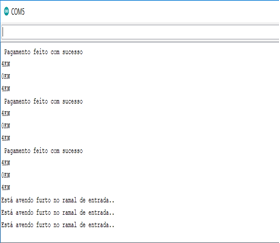
Fig. 15-Electricity fraud.
Source: (Author's own, 2024).
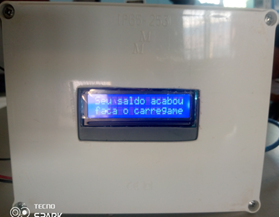
Fig. 16-Final meter interface indicating no recharge.
Source: (Author's own, 2024).
DISCUSSION
The article analyzes the application of the Internet of Things (IoT) in smart grids, focusing on the development of a prepaid energy meter with wireless communication. This innovation aims to increase efficiency in consumption control and transparency in billing, allowing users to top up their accounts via mobile devices. The research addressed the challenges of implementing these systems, including the need for a high initial cost and automatic disconnection in case of exhausted credits. The prototype developed enables real-time fraud detection, promoting greater security and reliability in the energy distribution service. The results demonstrated that the integration of wireless communication technologies not only improves energy consumption management, but also offers a user-friendly interface for users, facilitating the monitoring of their energy bills.
ACKNOWLEDGMENTS
I express my gratitude to God for life and wisdom. I thank my family, especially my parents, Adão Correa Sebastião and Maria António André Simão, for their unconditional support during my education. I am grateful to my wife, clinical psychologist Nady Sebastião Manuel Piedade, and to my children, Dulce, António and Mário, for their understanding regarding my absences and for strengthening me in difficult times.
REFERENCES
Andrade, J. E. (2021). Sistemas de tarifação pré-paga para o consumo de eletricidadeý£ Benefícios.
Ferreira, L. (2020). Eficiência operacional em sistemas de pagamento pré-pago de energia elétrica.
Santos, P. (2020). Desafios e perspectivas da adoção de medidores pré-pagos de energia elétrica.
Silva, R. (2019). Impactos da interrupção no fornecimento de eletricidadena economia e segurança. Revista de Políticas Energéticas.
Declaration of conflicts of interest:
The author of the article declares that there is no conflict of interest that affects the publication of the article.
Authorship Contribution:
The author also contributed to the conception, design and bibliographic research, which enabled the development and review of the content for final approval of the version to be published.
![]()
This work is under a Creative Commons Attribution-NonCommercial 4.0 International License